In This Issue
-
Lo Yi-chun and Jane Ingram Allen ● Taiwan: Art Activists
-
Denny Riley ● Rhodessa Jones
-
Claudia Bernardi ● US Border: Jailed Minors
-
Loraine Leeson ● London: Active Energy
-
Beverly Naidus ● Tacoma WA: Makeover
-
Robin Rosenthal ● US Census #CountMeIn
-
Danielle Siembieda ● Cultural Commentary Project
-
Susan Leibovitz Steinman ● Mildred Howard Local Hero
-
Atefeh Khas and Raheleh Minoosh Zomorodinia ● EMOTIONAL NUMBNESS: THE IMPACT OF WAR ON ECOSYSTEMS
-
Susan Leibovitz Steinman ● Women Art Politics
Politics in Contemporary Taiwanese Art
INTRODUCTION
POLITICS AND CONTEMPORARY ART are inextricably linked in Taiwan, perhaps more so than in other countries because of Taiwan’s history and its unique position in the world today. Though a democratic and independently governed country, it is not recognized as a sovereign nation, mainly because China claims Taiwan as a part of China that must be ‘re-unified’.1 Today this issue is even more stressful due to increasing pressures from China and the current Hong Kong situation.2 The slogan ‘Today’s Hongkong; tomorrow’s Taiwan’ is rooted in the minds of Taiwanese. Taiwan is a sort of hyper-politicized society, and Taiwanese are very active in voting, campaigning and discussing political issues. Voting is a very important civic action in Taiwan, and 75% of voters actually voted in some recent presidential elections. Taiwanese are also interested in environmental issues, international trade and economic issues, and of course in national identity, democracy and human rights. Taiwan became the first Asian nation to recognize same sex marriages in May, 2019.3 However, until recently not many younger artists focused on political issues, and the younger generation seemed disengaged from politics. This seems to be changing in recent years, especially with the re-election in 2020 of President Tsai Ing-wen, Taiwan’s first female president who advocates sovereignty and independence for Taiwan.4
I. ART OF KUO YU-PING
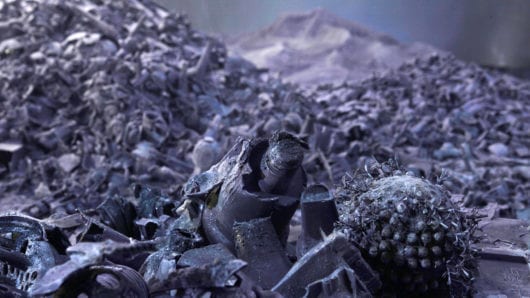 EASTERN MESSIAH, Kuo Yu-ping, 2015. Photo courtesy of Kuo Yu-Ping.
EASTERN MESSIAH, Kuo Yu-ping, 2015. Photo courtesy of Kuo Yu-Ping.
ONE OF THE MOST INTERESTING YOUNGER generation artists in Taiwan, Kuo Yu-ping, is making artworks that examine politics and government along with history and her personal memories. Kuo was born in Nantou, Taiwan, in 1986, and completed her master’s degree in trans-disciplinary arts at National Taipei University of the Arts. Her present work is a mix of painting, video, installation, and performance. Her works grow out of memories of her childhood home in Chung Hsing New Village. In her artist’s statement, Kuo writes:
The Chinese Nationalist Party (KMT) built and treated ‘Chung Hsing New Village’ as a special administrative district in 1957 in reference to British town planning. In view of the relatively stalemated situation of the Chinese civil war and the Cold War ideology at that time, the motivation in constructing ‘Chung Hsing New Village’ derived not only from KMT’ s allusion to taking back mainland China, but more profoundly from the nationalist ideology embraced by the ruling elites (who) fled from China to Taiwan.’5
Kuo’s 2015 work Eastern Messiah consists of a single channel video, installation and a series of 12 storyboard-like paintings. All of it is interrelated and shows the story of a family driving along a freeway seeing simulated ruins Kuo created from discarded debris, depicting the traumas of modernization and wars. Her work references Taiwanese memorial sites and governmental infrastructure built throughout the KMT ruling period (about 1947-1987). Kuo’s artwork seems to exemplify the Feminist slogan ‘the personal is political’,6 and her personal history relates to contemporary politics and Taiwanese identity issues. As Yi-chun Lo says about the work of Kuo Yu- Ping,
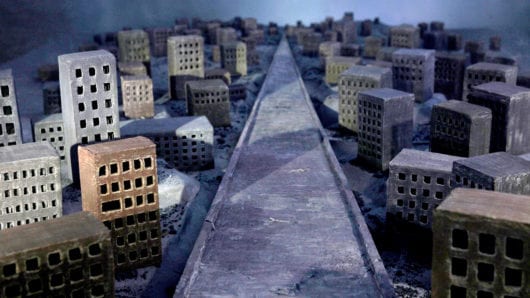 EASTERN MESSIAH, Kuo Yu-ping, 2015. Photo courtesy of Kuo Yu-Ping.
EASTERN MESSIAH, Kuo Yu-ping, 2015. Photo courtesy of Kuo Yu-Ping.
Kuo explored the social structures that related to her personal experience, national ideology, and collective consciousness that developed with the diplomatic relations during the Cold War and the financial support of the US through the Marshall Plan Period in Taiwan (1951-1965). People’s prosperity and quality of life did grow with modernization, but there was also the ‘White Terror’ time in Taiwan (1947-1992).7
Everyone in Taiwan probably knows someone who suffered or was killed during the ‘white terror’ time, and Kuo’s artworks examine this contentious political period in Taiwan’s history, filtered through her own experiences.
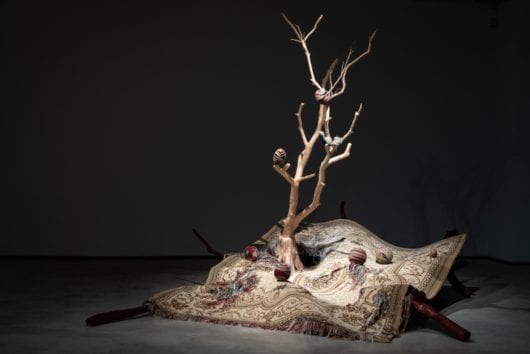
HOW REAL IS YESTERDAY – ASLEEP, DREAM, IN A FEVERISH LAND, Kuo Yu-Ping, 2019. Photo courtesy of Kuo Yu-Ping.
Other works of Kuo also examine political issues blended with her personal history. An example is her 2019 exhibition/installation titled How Real is Yesterday. This work invokes a subtle and complex narrative that revolves around her idea of home. The entire exhibition space embodies her inner landscape.
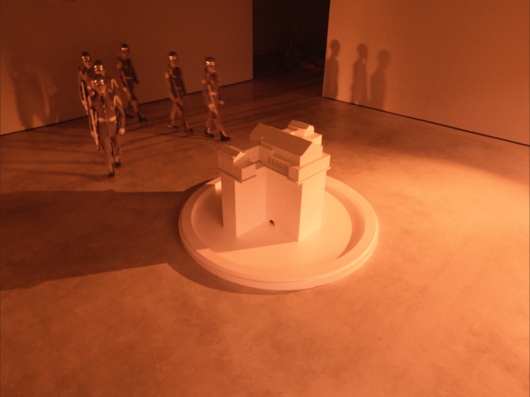 DOUBLE READING, Kuo Yu-Ping, 2019. Photo courtesy of Kuo Yu-Ping.
DOUBLE READING, Kuo Yu-Ping, 2019. Photo courtesy of Kuo Yu-Ping.
Double Reading (2019), a video work included with the installation, attempts to excavate what lies deep within the artist’s subconscious. Via images of once-present honor guards, it elicits an inexplicable, haunting state of self-censorship.8
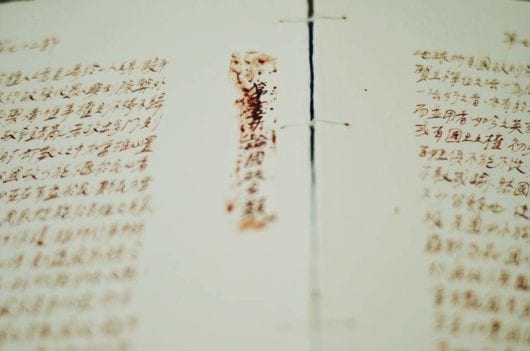 AUTONOMY, Kuo Yu-Ping, 2016. Photo courtesy of Kuo Yu-Ping.
AUTONOMY, Kuo Yu-Ping, 2016. Photo courtesy of Kuo Yu-Ping.
In another mixed media installation work titled Autonomy Kuo transcribes with her own blood the words from a 19th century British textbook about political economics, wiping out this institutional and colonialist text and asserting her own freedom and autonomy.
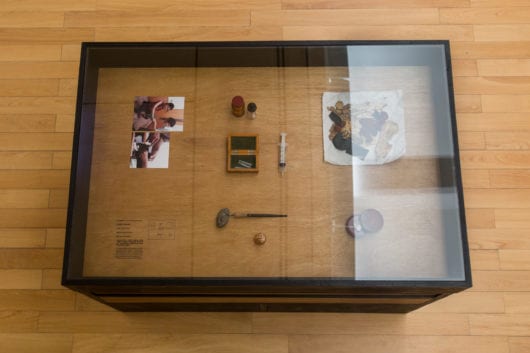 AUTONOMY, Kuo Yu-Ping, 2016. Photo courtesy of Kuo Yu-Ping.
AUTONOMY, Kuo Yu-Ping, 2016. Photo courtesy of Kuo Yu-Ping.
In another sound and installation work from 2018 There was no food in my stomach, sun on the back of my neck, love on my mind, panic in my soul, and an ache in my heart Kuo uses her own hair to construct parts for the sculptural installation that reflects on issues of identity and migration. These artworks illustrate Kuo’s continuing interest in how art, politics and the personal connect.9
II. ART OF LEE TZU-TUNG
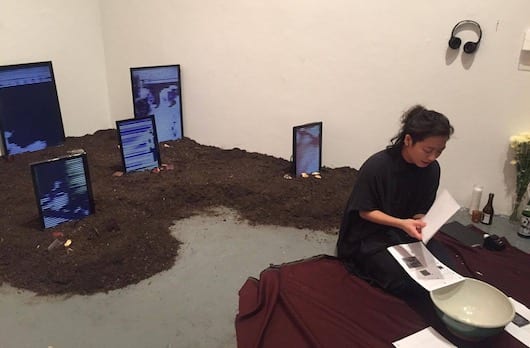
GHOSTKEEPERS, Lee Tzu Tung, 2019. Photo courtesy of Lee Tzu Tung.
LEE TZU-TUNG, ANOTHER YOUNGER GENERATION Taiwanese artist, also makes powerful multi- media works connected to politics and government. Lee sees her art as a part of being a political activist.10 After receiving her BS degree from National Taiwan University, Taipei, in 2012, Lee went on to study at the Sorbonne in Paris, France, and the University of Iceland in Reykjavik, Iceland, and obtained her MFA degree in 2017 in film, video and new media from the School of the Art Institute, Chicago. She is presently a candidate for a MS degree in Science, Art, Culture and Technology at MIT (Massachusetts Institute of Technology), Boston. In her current art practice she mixes all of this experience in forms such as performance art, web art, installation art, and film/video while maintaining an active involvement in many political and social movements in Taiwan. Lee’s artworks are concerned about current political issues effecting Taiwan and issues of national identity, especially as related to the situation in Hong Kong and the relationship between Taiwan and China. She represents the concerns and anxiety of new generation artists in Taiwan in this present unstable era.11
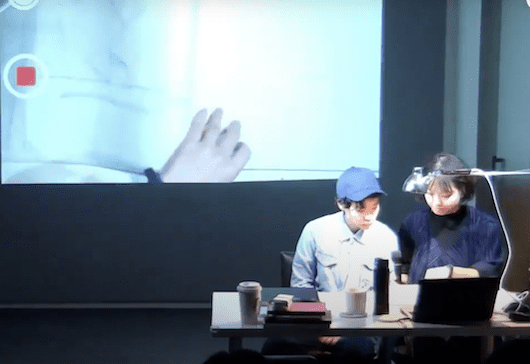 TRANSLATION, Lee Tzu Tung, Performance Artist Book, 2017. Photo credit: ET@T
TRANSLATION, Lee Tzu Tung, Performance Artist Book, 2017. Photo credit: ET@T
Lee is committed to making her art participatory and involving people in it directly. This participatory element sets Lee’s work apart from other younger artists in Taiwan who are concerned about social and political issues but not so much about involving people directly in the art. Her 2019 work Ghost Keepers is a 5-channel video installation that uses social media and invites the audience to make Facebook posts that tell their own stories of struggles against violence and oppression. This has become a multi-cultural multi-country project that emphasizes transcultural empathy and understanding of multiple points of view and the histories of government suppression and violence around the world. Yi-chun Lo comments about this work, ‘Lee’s meaningful work GhostKeepers presents the forgotten stories in history, and this work offers a chance for people to examine past traumas and provides an empathetic way for people to remember and heal through the social media ritual in the artwork.’

WRITING THE TIME LAG, Lee Tzu Tung, 2019. Photo courtesy of Lee Tzu Tung.
Writing the Time Lag 2019, is an experimental documentary in which Lee also includes other people’s stories and history. Yi-chun Lo comments further about Lee’s work,
I admire her actions exploring questions about identity and nationality from her interior monologue ‘Translation’, 2017, to the political actions that she has participated in such as the ‘Occupy Movement in Taiwan’.12 Probably because of her cross- disciplinary background and overseas experiences, she sees things from different angles and through different eyes. She is aware of who owned the authority to write the history, and she tries to reveal the unofficial histories that have been left behind. Also, she is highly sensitive about the interfaces that convey information and ideology today, and she is concerned about the manipulation through media that affect the ways people think. In her intriguing video work Writing the Time Lag, 2019, I particularly like this monologue, ‘Could you pass through the screen and reach where I am? Could you pass through the screen and reach this moment?’. In the surprising ending she reveals that what you see and what you hear and even what you feel could be a fraud with a glittery cover to delude people. This is what we face today with the media manipulation and disinformation, especially in the period before the Taiwan presidential election.13
III. ART OF JAO CHIA-EN
JAO CHIA-EN IS ANOTHER Taiwanese contemporary artist whose work is related to politics and government, often filtered through Taiwan’s history. Jao received his bachelor’s degree in fine arts from the Taipei National University of the Arts (2000) and graduated from the EÌcole Nationale SupeÌrieure des Beaux-arts in Paris (2004). He also studied at Goldsmiths, University of London, where he received his master’s degree in fine arts (2007), and attended a residency program in Paris in 2007. (Footnote # 14) His international experience contributes to his perspective on Taiwan’s political, economic and social situations, but his art is strongly connected to his roots in Taiwan. His project-based art practice crosses mediums and includes drawing, performance, and video installations.14
Jao’s 2016 video work Taxi is a good example of how his artwork considers political issues and refers to history, and it also reflects his anthropologist-like approach to art making. The video adopts a documentary style as Jao chats with different taxi drivers in Taipei while being driven by them to various politically contested sites in the city.
 TAXI, Jao Chia-En, 2016. Photo courtesy of Jao Chia-En.
TAXI, Jao Chia-En, 2016. Photo courtesy of Jao Chia-En.
These include destinations such as the Grand Hotel, the site of the highest-ranking Shinto shrine during Japanese colonial rule (1895 – 1945), and another famous political site, the Taipei foundation and memorial of Cheng Nan-Jung. Cheng Nan-Jung was a champion for freedom of speech and democracy in Taiwan and immolated himself in 1989 at this site as a protest against curbs on freedom of speech.15 For his Taxi video Jao records from the back seat the conversations he has with taxi drivers as they meander through memories of Taiwan’s decades-long martial law (1949 – 1987) which followed the Japanese occupation that ended in 1945, through the time of the Cold War (1947- 1991), the 2/28 incident (1947), the White Terror period (1949 – 1992) and up to present-day social and political topics. The different narratives that emerge challenge predefined understandings of city landmarks and comment on politics today and yesterday.
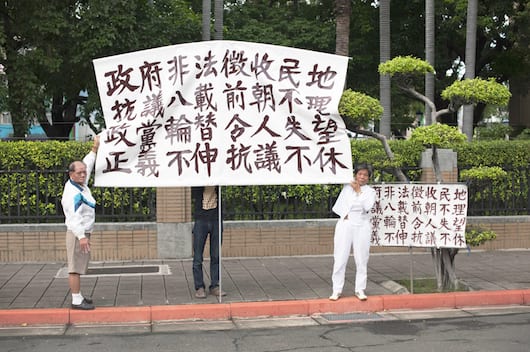
TAIWAN PROTEST TYPOGRAPHY, Jao Chia, 2009. Photo courtesy of Jao Chia-En.
Other works by Jao such as Taiwan Protest Typography in 2009 and 30 Proposals of Flag also in 2009, are questioning the role of artists themselves in society and examining how the national consciousness has been structured. Taiwan Protest Typography is about political protest signs made by a pair of siblings who have been protesting on the streets in Taiwan for more than 10 years. He magnifies and transmutes the protest signs to an unhandy size. The words of protest can still be seen clearly, yet the function of the signs as protest signs has been lost due to the inconvenient size and scale.
In 30 Proposals of Flag Jao creates 30 different possibilities for a national flag of Taiwan that are displayed as a suspended installation. Yi-chun Lo continues about this work,
Jao uses massive numbers of symbols and icons of Taiwan from different historical periods, including such things as economic crops, architecture, and historical figures. By creating these flags inspired by many different symbols and icons of Taiwan over the long period of its history, Jao examines the ideology that has been gathered from individual to group, from family to nation, to become a consciousness of national identity.
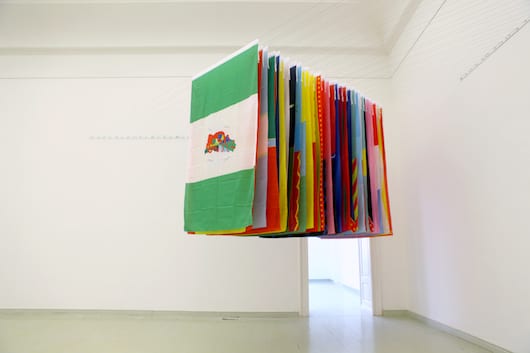
30 PROPOSALS OF FLAG, Jao Chia, 2009. Photo courtesy of Jao Chia-En.
These two 2009 interventions by Jao illustrate his ongoing focus on the role, the duty and the function of artists in society and question how artists can respond to politics and government issues.
IV. ART OF BETTY APPLE
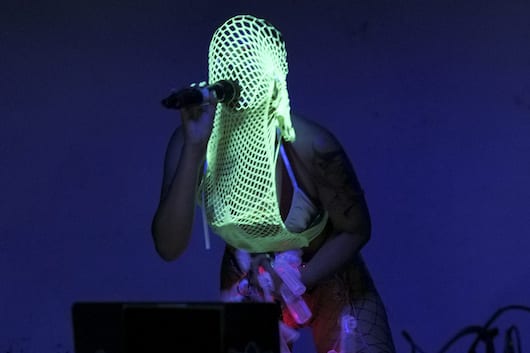
VIBRATOR LOVE OF SOUND 15, Betty Apple, 2019. Photo credit: Connor Crawford.
BETTY APPLE, AKA CHENG YE-PING, is another younger generation Taiwanese artist whose art is connected to government and politics with her explorations about issues of human rights, national identity, and gender, as well as environmental issues connected to politics. Betty Apple received a BA in Theater and MA in New Media Art at Taipei National University of the Arts and has extensive experience in theater and film. In recent years she has specialized in live art performances. She has performed at many international sound art festivals and musical events in Taiwan as well as in other countries.16 Apple has long been concerned about problems of nuclear waste and how nuclear power affects the environment and politics in Taiwan. In December 2012 she released the first musical album in Taiwan to deal with anti-nuclear issues.17
 VIBRATOR LOVE OF SOUND 06, Betty Apple, 2014. Photo credit: Laura FU.
VIBRATOR LOVE OF SOUND 06, Betty Apple, 2014. Photo credit: Laura FU.
Apple’s artworks mix themes of environmental protection, nuclear waste, national power, the image of women, sex, and sound into intense and thought-provoking performance art with electronic music, human voice, lights and movement. Apple likes to call her work ‘noise’ to question acceptable pretty and correct musical sounds and enlarge our perceptions. During Apple’s 2019 performance art tour in New Zealand, she commented in an interview that she sees the world in hypertext.18 Hypertext is an enlightening way to describe Apple’s view of the world and her art. Her performances link together many seemingly unconnected things and concepts in a non-sequential, non-logical way that comments on political, social and environmental issues.
 VIBRATOR LOVE OF SOUND 06, Betty Apple, 2014. Photo credit: Laura FU.
VIBRATOR LOVE OF SOUND 06, Betty Apple, 2014. Photo credit: Laura FU.
Betty Apple’s series of live performance art titled Vibrator Love of Sound (2012 – 2019) is an example of her multi-media blend of sound art, installation and live performance.19 Lo Yi-chun comments about the artwork of Betty Apple,
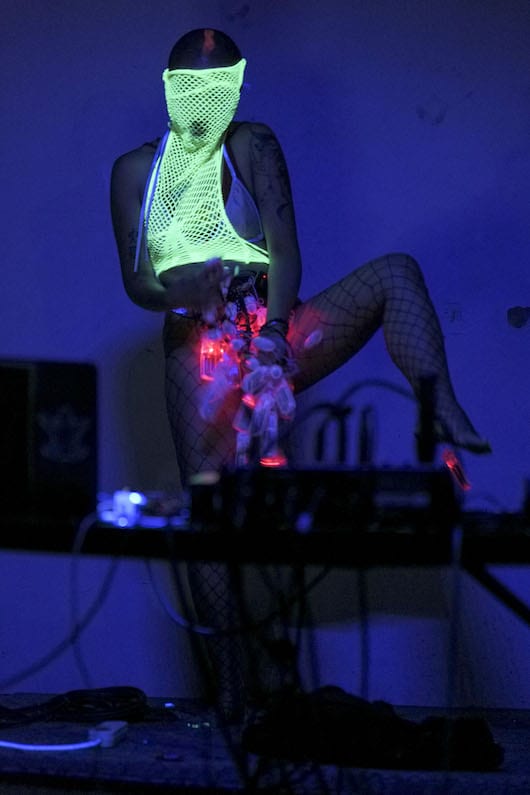 VIBRATOR LOVE OF SOUND 15, Betty Apple, 2019. Photo credit: Connor Crawford.
VIBRATOR LOVE OF SOUND 15, Betty Apple, 2019. Photo credit: Connor Crawford.
Vibrator Love of Sound started in 2012 and continues, evolving with different times, spaces, environments and the current issues or phenomena in society. Apple is sometimes inspired by the issue of nuclear power – a massive product of modern civilization to fulfill the collective desire with the indecomposable waste buried somewhere out of sight, out of mind. A key element in her work, ‘sex drive’, prompts her to explore the fluidity among genders and to challenge the stereotyped framework of the female image. In her performances, she utilizes different factory-made objects that are produced fast and cheap, such as plastic toys, balloons, fluorescent tubes, that vary by each occasion, but nearly always she includes the sex toy, plastic vibrators made in Taiwan. While she drags out a bunch of vibrators from the bottom of her dress, the sound of trembling vibrators colliding is amplified to an unbearable noise, representing the ‘Post-Industrial Soundscape’ that she grew up in.20 During the performance, she often screams into the microphone to break the authoritative power it emblemizes.
Another Apple performance artwork Human Being is Just a Legend 21 reflects her ongoing concerns about global warming and rising waters and all the political implications of those phenomena. Lo Yi-chun writes about this work,
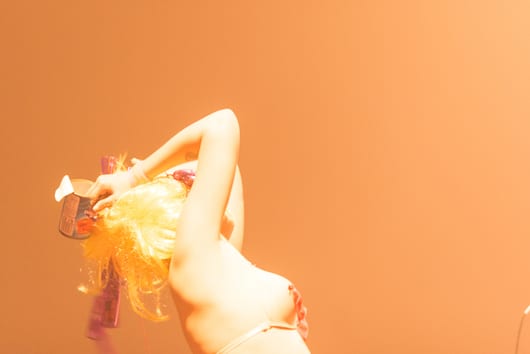
HUMAN BEING IS JUST A LEGEND, Betty Apple, 2018. Photo credit: Keelan O’Hehir.
Human Being is Just A Legend is based on Apple’s fictional story about a time when all humans died out from global warming, and only A.I. robots who look like mermaids remained. They found tin cans, a long-lasting food item from the human world, and also vibrators, cheap sex toys that are waterproof and adapt well to being in water. Mermaids enjoy the flow of water which recalls the nature of sounds and the fluidity of genders.
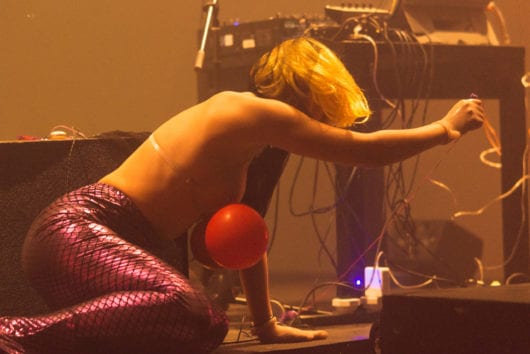
HUMAN BEING IS JUST A LEGEND, Betty Apple, 2018. Photo credit: Keelan O’Hehir.
Apple provided empty tin cans with vibrators in them so that the audience could also make noise during this performance piece, while she, the A.I. mermaid, swam in the venue, played music, and produced noise, representing chaos and the origin of life. During the performance the mermaid took off her catchy wig and her rubber outfit piece by piece, and at the end destroyed all the vibrators, to get rid of the framework/definition of appearance and examine our relationship with the environment. Betty Apple says in her talk at ACCA, Australian Centre for Contemporary Art,
‘In the end, all the relationships will be out of control (like the vibrators in the show); even though you wanted to turn it off, they still exploded, like Fukushima Nuclear Power plant. We have the same issue in Taiwan. Our government built up the complicated computer system to control nuclear power plants. Our government is so proud of it, but people are so scared that it will be like this (out of control). If it explodes, it will be really crazy. And in the end, you have to destroy everything. That is my question about life and all the things in modern life.’ 22
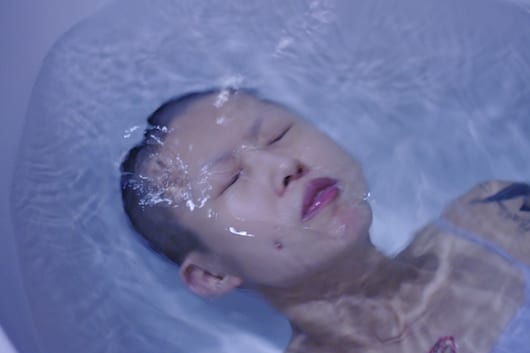
MIRAGE CITY UNDER THE LAKE- TAIPEI, Betty Apple, 2017. Photo courtesy of Betty Apple.
Another Apple performance art piece Mirage City Under the Lake – Taipei 23 also reflects Apple’s ongoing focus on global warming. Politics is strongly connected to environmental concerns in Taiwan. An environmental or eco art movement began in Taiwan about 2005.24 One of the pioneers of environmental and social practice art in Taiwan is Mali Wu.25 Wu is a teacher, curator and artist doing public art projects about environmental and political issues related to destruction of waterways and global warming. One of Wu’s most important art projects that began in 2009 is titled xi This ‘cultural action’ aimed to raise community dialog about Taipei’s waterways. Another important artwork by Mali Wu titled Taipei Tomorrow a Lake Again may also show Wu’s influence on younger artists such as Betty Apple with her work Mirage City Under the Lake – Taipei.

MIRAGE CITY UNDER THE LAKE- TAIPEI, Betty Apple, 2017. Photo courtesy of Betty Apple.
V. ART OF LO YI-CHUN
LO YI-CHUN (CO-AUTHOR OF THIS ARTICLE) is also a younger generation Taiwanese artist who has created impressive art connected to the environment and politics. In more recent years Lo’s artwork has evolved to focus on the political connections of global trade and migration, although she is still a committed environmental artist. Through her experiences working in rural agricultural communities and her international residencies, she has become particularly interested in the politics of international trade. International trade, as we have seen from recent episodes in the US of banning trade and imposing tariffs, is a political issue and even connected to national security. Lo focused her attention on economic crops of Taiwan such as bananas, tobacco and sugar cane.26
About her recent artworks and its political connections, Lo states,
These works began from a concern about farming issues, such as the crops, the social warfare of farmers and workers, and the local markets that were affected by the international market in the global world. All of the above led me to create the first works I made entirely from banana peels, Banana in Taiwan, Japan and the Philippines, 2013, to address the banana trade between Taiwan, Japan and the Philippines, which revealed stories about the past thriving banana kingdom of Taiwan and the political manipulation back to the late 1960s. In 2014, when I was at a residency in the US, I looked into the history of the ‘banana republics’ in the Americas which struck me heavily, and it was hard for me to believe the inhuman past that built up the global banana chain. Inspired and touched by this research, I created three artworks assembled into one installation: History of Banana Republic, The Boycott of Market Basket, Umbrella Revolution in HK.27
In 2015, I witnessed the European refugee crisis while I was traveling in Europe. From this experience and my research on issues of migration and politics, I created five boats from banana peels to reflect conflicts with contemporary national borders and the political power behind immigration issues. This became my Voyage to the Homeland installation.28
Lo’s large-scale installation titled Voyage to the Homeland examines migration issues and how they are connected to politics using her personal experiences encountering migrants in her travels as well as thinking about Taiwan’s dealings with immigrants and its aboriginal peoples. Another work in 2017 titled Taste of Ocean further explored immigration issues and focused on the immigrant workers in Taiwan.29
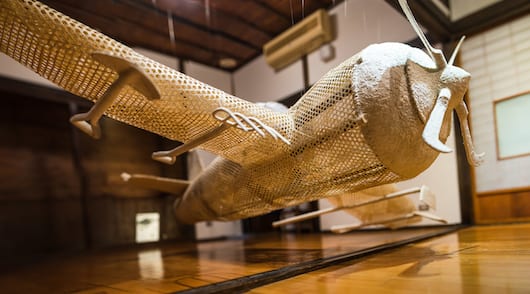
SUGARCANE FIBER, MOLASSES, ETHANOL-BLENDED AVIATION GASOLINE. JUST WHAT IS IT THAT MAKES TODAY’S SUGARCANE FIELDS SO DIFFERENT, SO APPEALING?, Lo Yi-Chun, 2019. Photo Credit:Madou Sugar Industry Art Triennial.
More recently in 2019, Lo focused her art on the sugarcane crop and industry of Taiwan. After research, she came to realize that the hidden purpose for the Japanese empire to build many sugarcane factories in Taiwan was not only for sugar, but also for the potential to produce ethanol for military usage. She is especially interested in the role of sugar as it transformed from being an edible commodity to a commercial commodity and then to military supplies. Her 2019 installation is titled Sugarcane Fiber, Molasses, Ethanol-blended Aviation Gasoline. Just What Is It That Makes Today’s SUGARCANE FIELDS So Different, So Appealing? 30
About her artwork and its connections to politics, Lo concludes,
Political issues are embedded in my artworks through the agricultural/trade issues and the migration issues I explored. I feel that I am a story teller. I present the hidden history and political connections in another perspective, with the visual objects that I display, with the special materials I use, and with the smell and the history of the material itself.
 SUGARCANE FIBER, MOLASSES, ETHANOL-BLENDED AVIATION GASOLINE. JUST WHAT IS IT THAT MAKES TODAY’S SUGARCANE FIELDS SO DIFFERENT, SO APPEALING?, Lo Yi-Chun, 2019. Photo Credit:Madou Sugar Industry Art Triennial.
SUGARCANE FIBER, MOLASSES, ETHANOL-BLENDED AVIATION GASOLINE. JUST WHAT IS IT THAT MAKES TODAY’S SUGARCANE FIELDS SO DIFFERENT, SO APPEALING?, Lo Yi-Chun, 2019. Photo Credit:Madou Sugar Industry Art Triennial.
This is the most powerful and moving kind of political art; it does not hit one over the head with a strident message, but introduces a new perspective and makes one think differently to reimagine the future.
VI. CONCLUSIONS
POLITICS IS ONLY ONE ASPECT of an artist’s work, and to be art it has to transcend just the political. All of these younger artists from Taiwan are making important art as well as making us think about political issues in different ways. One thing that marks the Taiwanese contemporary art connected to politics as unique is the Taiwanese artists’ all-pervading search for personal and national identity and the use of individual and collective history. Each one filters their concerns through the history of Taiwan and their own personal experiences. These artists have all traveled widely to give them a global perspective as well as the uniquely Taiwanese one.
FOOTNOTES
- More about Taiwan must be re-unified with China: https://www.straitstimes.com/asia/east-asia/xi-jinping-says-china-must-be-will-be-reunified-with-taiwan
- More about Hong Kong and Anti-Extradition Law Movement: https://en.wikipedia.org/wiki/2019-20_Hong_Kong_protests
- More about legalizing same sex marriage in Taiwan: https://www.cnn.com/2019/05/17/asia/taiwan-same-sex-marriage-intl/index.html). And for more about LGBTQ related art exhibitions in Taiwan: https://frieze.com/article/spectrosynthesis-asian-lgbtq-issues-and-art-now
- More about Taiwan’s 2020 presidential election and changing attitudes of younger generation: https://www.nytimes.com/2020/01/11/world/asia/taiwan-election-china.html and https://www.aljazeera.com/news/2020/03/generation-nexthow-young-changing-taiwan-politics-200326070158729.html
- More from Kuo’s website about her home village, click on to PDF: http://www.kuoyuping.com
- More about the slogan ‘The Personal is Political’: https://en.wikipedia.org/wiki/The_personal_is_political
- White Terror time is sometimes defined as 1947-1987 when martial law was lifted, but it was not until 1992 that the law was revised to officially end this time when 3,000 to 4,000 were executed and about 140,000 imprisoned for opposition to the KMT government of Chiang Kai Shek: https://en.wikipedia.org/wiki/White_Terror_(Taiwan) https://books.google.com.tw/books?id=LkDxBQAAQBAJ&pg=PA61&lpg=PA61&dq=Article+100+of+Criminal+Code+of+the+Republic+of+China+revised+freedom&source=bl&ots=wToKLB0ml-&sig=ACfU3U0oI3IP0vqm9eqqxPuheZFw-usguw&hl=zh-TW&sa=X&ved=2ahUKEwj33p7a0PjpAhW_yYsBHYQlBrQQ6AEwBHoECAcQAQ#v=onepage&q=Article%20100%20of%20Criminal%20Code%20of%20the%20Republic%20of%20China%20revised%20freedom&f=false)
- Review of Kuo’s exhibition ‘How Real is Yesterday’ in Art Forum magazine: https://www.artforum.com/picks/Kuo-Yu-Ping-80483?fbclid=IwAR1RY8D3-AWNu4YAVywZfGLy6XxPaXOs2hb7Ot_jQ1T_rOXEAwjcgPdzGFg
- More about the works of Kuo Yu-ping: http://www.kuoyuping.com/wp-content/uploads/2016/03/2017KUO英文簡淖電å版.pdf
- Website of Lee Tzu-tung: https://www.tzutung.com/home
- BBC Interview with Lee about her art and connection to politics: https://www.bbc.co.uk/sounds/play/w3csynbq?fbclid=IwAR20ZbpYm2-VDz1rDKM_IGuXP_oBmqUU14Kk1rmNMPD9hqo30AXvhXlhTow
- More about the worldwide ‘Occupy Movement’ and the ‘Sunflower Movement’ in Taiwan: https://en.wikipedia.org/wiki/Occupy_movement
- More about Lee’s work ‘Writing the Time Lag’: https://www.tzutung.com/writing-the-time-lag
- More about Jao Chia-En and his artwork: https://chiaenjao.co.uk
- More about Cheng Nan-Jung: https://en.wikipedia.org/wiki/Cheng_Nan-jung
- More about Betty Apple and her artwork: https://bettyapple.art
- More about Betty Apple’s release of first anti-nuclear album in Taiwan: (https://i-love-nuclear.bandcamp.com/releases
- Excerpt from Betty Apple interview in New Zealand-seeing the world as hypertext: https://thespinoff.co.nz/music/31-07-2019/i-see-the-world-in-hypertext-a-conversation-with-musician-betty-apple/?fbclid=IwAR17DmyoYKNb_xuU93RfI8npz9MoB961UFtmzWiFChhdo9w2l8z4Ahtvupk
- Link to Apple’s Vibrator Love of Sound’ performance videos: https://www.youtube.com/watch?v=GznusVW9S0w and https://www.youtube.com/watch?v=7z0C35N4wr8&t=482s
- More about the ‘Soundscape’ concept in Apple’s work that was influenced by the R. Murray Schafer book Soundscape published in 1993: https://www.amazon.com/Soundscape-R-Murray-Schafer/dp/0892814551
- Link to Apple’s performance video ‘Human Being is Just a Legend’: https://www.youtube.com/watch?v=T2jNTQuAxJc
- More about Betty Apple’s performance at ACCA and interview: https://acca.melbourne/program/negative-volumes-shining-abyss
- Link to Apple performance work ‘Mirage City Under the Lake – Taipei’: https://www.youtube.com/watch?v=6-3JgseL7Yc
- More about the development of environmental art in Taiwan: http://ecohumanities.org/2016/12/04/fresh-perspectives-on-art-and-ecology-taiwan/
https://artradarjournal.com/2013/05/13/art-and-social-change-how-environmental-art-is-transforming-a-taiwanese-village/
https://issuu.com/bamboocurtainstudio/docs/v9_creative_environment__taiwan__on - More about Mali Wu and her artwork: https://directory.weadartists.org/artist/maliw
- Link to website of Lo Yi-chun: https://yichunlo.wixsite.com/artist/about
- More about Lo’s work ‘Banana Justice’: https://yichunlo.wixsite.com/artist/banana-justice-
https://artradarjournal.com/2014/12/05/taiwanese-artist-yi-chun-lo-talks-bananas-and-economics-interview/ - More about Lo’s ‘Voyage to the Homeland’: https://yichunlo.wixsite.com/artist/voyage-to-the-homeland https://www.asianartbiennial.org/2017/content/EN/ArtistDetail.aspx?enc=EEB704F345ADA9DADCF494B31E8728D7
- More about ‘Taste of Ocean’: https://yichunlo.wixsite.com/artist/taste-of-ocean
- More about Lo’s Sugar Cane Work: https://madou-sugarindustry-triennial.tnc.gov.tw/en/works_view/28
